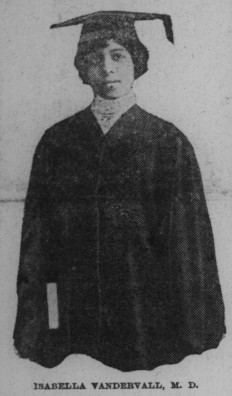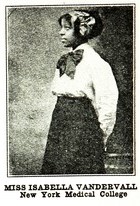Isabella Vandervall facts for kids
Quick facts for kids
Isabella Vandervall
|
|
|---|---|
 |
|
| Born | |
| Nationality | American |
| Alma mater | New York Medical College |
| Occupation | Physician, Gynaecologist |
|
Notable work
|
'Some Problems of the Colored Woman Physician' |
Isabella Vandervall (1894–1989) was an African-American doctor who specialized in women's health. She was a strong supporter of better healthcare for everyone in New York City. Isabella was a very bright student. She graduated at the top of her class from the New York Medical College for Women.
Isabella's Early Life
Isabella Vandervall was born to Isabella (Braun) and James Nelson Vandervall. Her father was a successful businessman and a leader in their community in Orange, New Jersey. Isabella was an excellent student. She finished high school when she was just 16 years old.
In 1917, she married Dr. William Randolph R. Granger Jr. He had studied at Dartmouth College. His family also had many doctors. Isabella and William adopted a daughter named Mary Isabella. They were known as a very popular couple in Brooklyn.
Her Career as a Doctor
In the early 1900s, it was very hard for African-American women to become doctors. Many states started requiring doctors to complete an internship in a hospital. This was needed to get a medical license.
Isabella Vandervall finished her medical studies in 1915. She was the best student in her class. Even so, four hospitals turned her down for an internship. She had an amazing average grade of 97.8%. Sometimes, a hospital would offer her a spot. But when they found out she was African-American, they would take back the offer.
This happened when she was offered an internship at a hospital in Syracuse. Isabella wrote about it in a medical journal:
I found the hospital; I found the superintendent. She asked me what I wanted. I told her I was Dr. Vandervall, the new interne. She simply stared and said not a word. Finally, when she came to her senses, she said to me: 'You can't come here; we can't have you here! You are colored! You will have to go back.'
Isabella was lucky because she got her medical licenses in New York and New Jersey before these new internship rules started. This allowed her to practice medicine. She explained how difficult these new laws made it for other women of color. She said it was an "almost insurmountable" challenge.
In 1920, there were 3,855 Black doctors in the United States. Less than half of one percent of them were women. The number of Black women doctors actually went down from 90 in 1890 to 65 in 1920.
Isabella's article in the Woman's Medical Journal brought attention to this problem. Another doctor, Emma Wheat Gilmore, wrote a response. She felt pity for Isabella. She said Isabella was qualified but could not practice because of unfair prejudice.
Isabella Vandervall later worked at the Mothers' Health Center. This center was part of the Harlem Branch of the National Urban League. She helped many people there.


